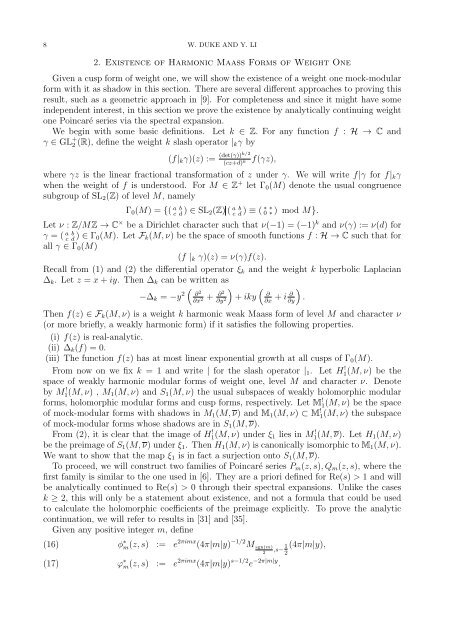Mock-modular forms of weight one - UCLA Department of Mathematics
Mock-modular forms of weight one - UCLA Department of Mathematics
Mock-modular forms of weight one - UCLA Department of Mathematics
You also want an ePaper? Increase the reach of your titles
YUMPU automatically turns print PDFs into web optimized ePapers that Google loves.
8 W. DUKE AND Y. LI<br />
2. Existence <strong>of</strong> Harmonic Maass Forms <strong>of</strong> Weight One<br />
Given a cusp form <strong>of</strong> <strong>weight</strong> <strong>one</strong>, we will show the existence <strong>of</strong> a <strong>weight</strong> <strong>one</strong> mock-<strong>modular</strong><br />
form with it as shadow in this section. There are several different approaches to proving this<br />
result, such as a geometric approach in [9]. For completeness and since it might have some<br />
independent interest, in this section we prove the existence by analytically continuing <strong>weight</strong><br />
<strong>one</strong> Poincaré series via the spectral expansion.<br />
We begin with some basic definitions. Let k ∈ Z. For any function f : H → C and<br />
γ ∈ GL + 2 (R), define the <strong>weight</strong> k slash operator | k γ by<br />
(f| k γ)(z) := (det(γ))k/2 f(γz),<br />
(cz+d) k<br />
where γz is the linear fractional transformation <strong>of</strong> z under γ. We will write f|γ for f| k γ<br />
when the <strong>weight</strong> <strong>of</strong> f is understood. For M ∈ Z + let Γ 0 (M) denote the usual congruence<br />
subgroup <strong>of</strong> SL 2 (Z) <strong>of</strong> level M, namely<br />
Γ 0 (M) = {( a c d b ) ∈ SL 2(Z) ( a c d b ) ≡ ( ∗ 0 ∗<br />
∗ ) mod M}.<br />
Let ν : Z/MZ → C × be a Dirichlet character such that ν(−1) = (−1) k and ν(γ) := ν(d) for<br />
γ = ( a c d b ) ∈ Γ 0(M). Let F k (M, ν) be the space <strong>of</strong> smooth functions f : H → C such that for<br />
all γ ∈ Γ 0 (M)<br />
(f | k γ)(z) = ν(γ)f(z).<br />
Recall from (1) and (2) the differential operator ξ k and the <strong>weight</strong> k hyperbolic Laplacian<br />
∆ k . Let z = x + iy. Then ∆ k can be written as<br />
−∆ k = −y 2 (<br />
∂ 2<br />
+ ∂2<br />
∂x 2<br />
) (<br />
+ iky<br />
∂y 2<br />
∂<br />
+ i ∂<br />
∂x ∂y<br />
Then f(z) ∈ F k (M, ν) is a <strong>weight</strong> k harmonic weak Maass form <strong>of</strong> level M and character ν<br />
(or more briefly, a weakly harmonic form) if it satisfies the following properties.<br />
(i) f(z) is real-analytic.<br />
(ii) ∆ k (f) = 0.<br />
(iii) The function f(z) has at most linear exp<strong>one</strong>ntial growth at all cusps <strong>of</strong> Γ 0 (M).<br />
From now on we fix k = 1 and write | for the slash operator | 1 . Let H ! 1(M, ν) be the<br />
space <strong>of</strong> weakly harmonic <strong>modular</strong> <strong>forms</strong> <strong>of</strong> <strong>weight</strong> <strong>one</strong>, level M and character ν. Denote<br />
by M ! 1(M, ν) , M 1 (M, ν) and S 1 (M, ν) the usual subspaces <strong>of</strong> weakly holomorphic <strong>modular</strong><br />
<strong>forms</strong>, holomorphic <strong>modular</strong> <strong>forms</strong> and cusp <strong>forms</strong>, respectively. Let M ! 1(M, ν) be the space<br />
<strong>of</strong> mock-<strong>modular</strong> <strong>forms</strong> with shadows in M 1 (M, ν) and M 1 (M, ν) ⊂ M ! 1(M, ν) the subspace<br />
<strong>of</strong> mock-<strong>modular</strong> <strong>forms</strong> whose shadows are in S 1 (M, ν).<br />
From (2), it is clear that the image <strong>of</strong> H ! 1(M, ν) under ξ 1 lies in M ! 1(M, ν). Let H 1 (M, ν)<br />
be the preimage <strong>of</strong> S 1 (M, ν) under ξ 1 . Then H 1 (M, ν) is canonically isomorphic to M 1 (M, ν).<br />
We want to show that the map ξ 1 is in fact a surjection onto S 1 (M, ν).<br />
To proceed, we will construct two families <strong>of</strong> Poincaré series P m (z, s), Q m (z, s), where the<br />
first family is similar to the <strong>one</strong> used in [6]. They are a priori defined for Re(s) > 1 and will<br />
be analytically continued to Re(s) > 0 through their spectral expansions. Unlike the cases<br />
k ≥ 2, this will only be a statement about existence, and not a formula that could be used<br />
to calculate the holomorphic coefficients <strong>of</strong> the preimage explicitly. To prove the analytic<br />
continuation, we will refer to results in [31] and [35].<br />
Given any positive integer m, define<br />
(16)<br />
(17)<br />
)<br />
.<br />
φ ∗ m(z, s) := e 2πimx (4π|m|y) −1/2 M sgn(m)<br />
,s− 1 (4π|m|y),<br />
2 2<br />
ϕ ∗ m(z, s) := e 2πimx (4π|m|y) s−1/2 e −2π|m|y .
















